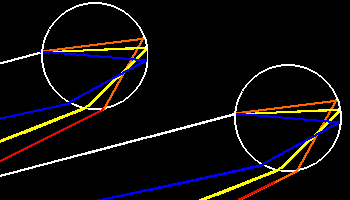

Rainbows are important symbols to the Navajo people. They bring good luck (it is certain that they bring rain!). Symbols of rainbows are used to act as guardians for the south, west and north sides of many sandpaintings. In order to understand that association of rainbows with the phenomenon of rain, we need to look at the geometrical situation that allows us to see rainbows.
In the desert southwest, thunderstorms occur in the late afternoon, when the sun is in the western sky. The thunderclouds have formed over the mountains and have moved off to deliver their moisture to the desert floor. When the rain is falling, it adds transparent, round particles to the atmosphere, through which the sunlight will pass. When the sunlight strikes a raindrop, the light is refracted (bent) because the water is (optically) denser than the surrounding air. We see this when we look into a basin of water and straight things appear to bend at the water's surface, because the light rays have bent. Some of the sunlight will not leave the water droplet at its back surface, but will be reflected back within the rain drop. Because the amount that light bends is a function of the color of the light, the colors are split within the water droplet, just as within a prism. When the light leaves the water droplet, the sun's rays have now been split into their component wavelengths (colors). We see the rays that have been bent sufficiently to return to us.
If we could see a rainbow formed by only one raindrop bending the light back to us (the sun will be behind you when you see a rainbow!), we would not see a full rainbow because the colors from a single drop would be bent over too large a range in angle to let all of them into a single eye. The rainbow we see are the result of many, many raindrops bending the sun's rays back toward us. Because of this, rainbows appear fuzzy, not sharp, and the color sequence is reversed from that delivered by a single drop. This is due to the fact that we receive the red light from raindrops that are higher in the atmosphere than those from which we see the blue light. The blue light from the drops that send us the red light passes over our heads unseen (by us). The red light from the drops that send us the blue light passes beneath us.
That explains why rainbows move when we move; we are seeing light from drops at different places in the atmosphere as we move around. We can never reach the end of the rainbow. It will always move away from us.